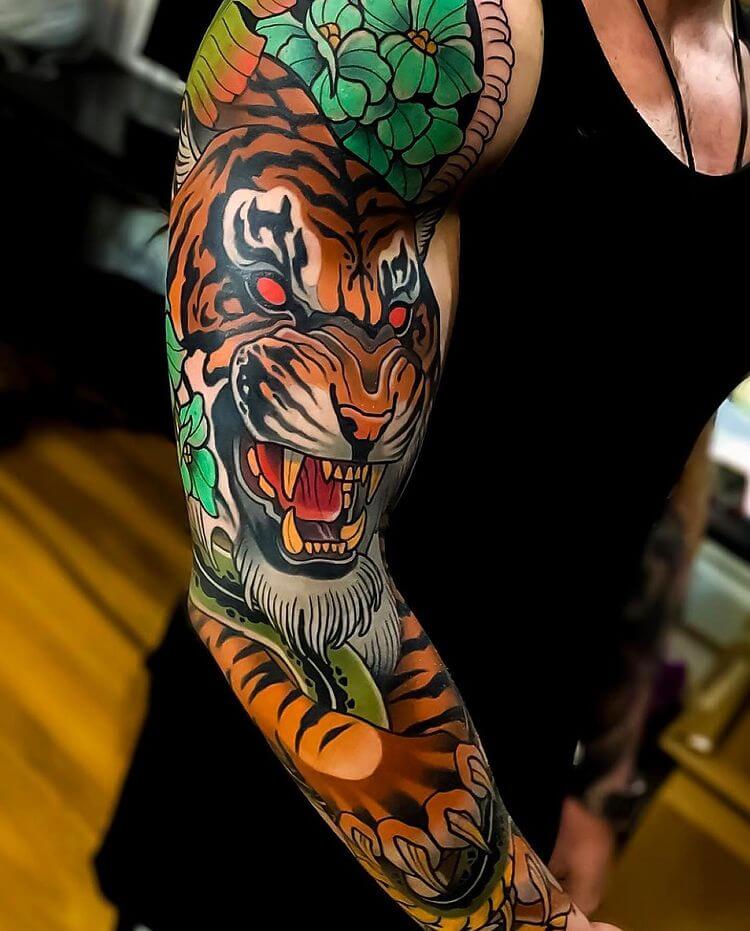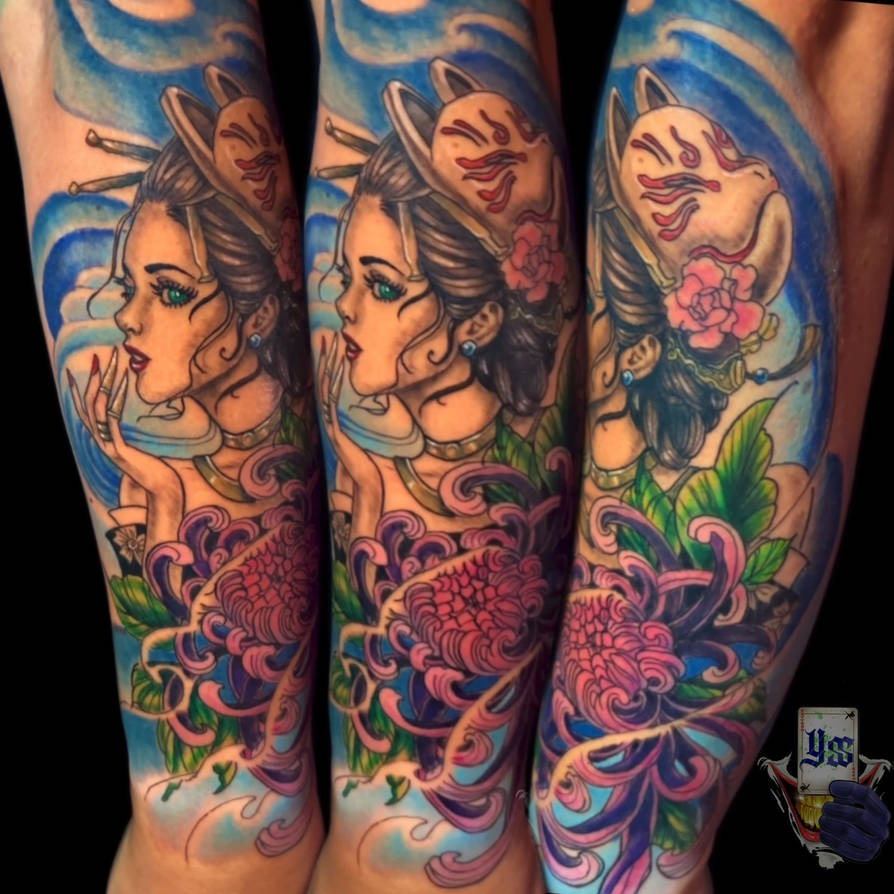Neo Japanese tattoos have become a global phenomenon, blending the rich heritage of traditional Japanese art with contemporary designs. This unique style captures the imagination of tattoo enthusiasts worldwide, offering intricate patterns and vibrant colors that tell a story. If you're captivated by the beauty of neo Japanese tattoos, this comprehensive guide will take you on a journey through its history, techniques, and cultural significance.
In recent years, the demand for neo Japanese tattoos has skyrocketed, as people seek to express their individuality through meaningful body art. Unlike traditional Japanese tattoos, which strictly adhere to ancient customs, neo Japanese tattoos embrace innovation while honoring the past. This fusion creates a style that appeals to a broader audience, combining classic motifs with modern aesthetics.
Whether you're an aspiring tattoo artist, a collector looking for inspiration, or simply curious about this captivating art form, this article will provide valuable insights into the world of neo Japanese tattoos. From its origins to current trends, we'll explore everything you need to know about this dynamic style.
Read also:Sheldon Actors A Comprehensive Guide To The Iconic Performers
Table of Contents
- The History of Neo Japanese Tattoo
- Traditional Japanese Tattoo vs Neo Japanese Tattoo
- Popular Neo Japanese Tattoo Designs
- Renowned Neo Japanese Tattoo Artists
- Techniques in Neo Japanese Tattooing
- Cultural Significance of Neo Japanese Tattoos
- Tattoo Care for Neo Japanese Ink
- Cost of Neo Japanese Tattoos
- Current Trends in Neo Japanese Tattoos
- Conclusion
The History of Neo Japanese Tattoo
Neo Japanese tattoos trace their roots back to the Edo period in Japan, where traditional irezumi (tattooing) flourished. During this era, tattoos were primarily associated with religious rituals, social status, and criminal branding. However, as time progressed, artists began experimenting with new techniques and designs, paving the way for the modern neo Japanese style.
Evolution of Japanese Tattoo Art
The evolution of Japanese tattoo art can be divided into several key phases. Initially, tattoos were hand-poked using bamboo tools, a method known as tebori. This painstaking process required immense skill and precision, resulting in highly detailed and durable tattoos. Over time, the introduction of electric tattoo machines allowed artists to create larger, more intricate designs with greater efficiency.
Today, neo Japanese tattoos incorporate elements from both traditional and modern tattooing techniques. Artists often combine tebori with digital tools to produce stunning works of art that honor the past while embracing the future.
Traditional Japanese Tattoo vs Neo Japanese Tattoo
While traditional Japanese tattoos adhere strictly to established rules and motifs, neo Japanese tattoos offer more creative freedom. This section explores the key differences between these two styles.
Key Characteristics of Traditional Japanese Tattoos
- Strict adherence to specific motifs such as koi fish, dragons, and cherry blossoms
- Use of bold black outlines and limited color palettes
- Often covers large areas of the body, such as sleeves or full-back pieces
- Deeply rooted in Japanese culture and history
Neo Japanese Tattoo Innovations
- Incorporation of contemporary elements like abstract shapes and modern color schemes
- Flexibility in design placement and size
- Blending of Western and Eastern artistic influences
- Appeal to a broader, global audience
Popular Neo Japanese Tattoo Designs
Neo Japanese tattoos offer a wide range of design options, allowing individuals to express their unique tastes and preferences. Below are some of the most popular motifs in this style:
Iconic Motifs in Neo Japanese Tattoos
- Koi fish: Symbolizing perseverance and strength
- Dragons: Representing power and wisdom
- Cherry blossoms: Signifying beauty and the fleeting nature of life
- Samurai: Embodying honor and discipline
- Wave patterns: Reflecting the dynamic forces of nature
Renowned Neo Japanese Tattoo Artists
The world of neo Japanese tattoos is home to many talented artists who have made significant contributions to the style. Here are a few notable figures:
Read also:Kip Pardue Family A Deep Dive Into His Life Career And Legacy
Top Neo Japanese Tattoo Artists
- Horiyoshi III: A legendary figure in the Japanese tattoo community, known for his mastery of traditional and neo styles.
- Chris Garver: A pioneer of neo Japanese tattoos in the Western world, famous for his bold and colorful designs.
- Mark Mahoney: Co-founder of Shamrock Social Club, renowned for his innovative approach to neo Japanese tattoos.
Techniques in Neo Japanese Tattooing
Creating a neo Japanese tattoo requires a combination of traditional and modern techniques. Artists must possess a deep understanding of both styles to produce high-quality work.
Key Techniques Used in Neo Japanese Tattoos
- Tebori: The traditional hand-poked method, still valued for its precision and authenticity.
- Electric tattoo machines: Offer greater speed and versatility, allowing for intricate details and vibrant colors.
- Layering: A technique used to build depth and dimension in the tattoo design.
Cultural Significance of Neo Japanese Tattoos
Neo Japanese tattoos carry significant cultural weight, bridging the gap between ancient traditions and modern sensibilities. This section delves into the cultural implications of this art form.
Respecting Cultural Heritage
While neo Japanese tattoos offer creative freedom, it's essential to approach them with respect for their cultural origins. Artists and clients alike should be mindful of the historical context and symbolism behind each design.
Tattoo Care for Neo Japanese Ink
Maintaining the vibrancy and longevity of a neo Japanese tattoo requires proper care. Follow these guidelines to ensure your tattoo remains in top condition:
Steps for Proper Tattoo Care
- Keep the tattoo clean and moisturized during the healing process.
- Avoid exposing the tattoo to direct sunlight for at least six weeks.
- Use high-quality tattoo aftercare products to promote healing.
Cost of Neo Japanese Tattoos
The cost of a neo Japanese tattoo can vary significantly depending on several factors, including the artist's reputation, the size and complexity of the design, and the location of the studio.
Average Costs for Neo Japanese Tattoos
- Small designs: $200-$500
- Medium designs: $500-$1,500
- Large designs: $1,500-$5,000+
Current Trends in Neo Japanese Tattoos
The world of neo Japanese tattoos continues to evolve, with new trends emerging regularly. Some of the latest trends include:
Emerging Trends in Neo Japanese Tattoos
- Minimalist designs featuring simplified motifs and reduced color palettes.
- Watercolor techniques that add fluidity and movement to traditional designs.
- Blackwork tattoos inspired by Japanese sumi-e painting.
Conclusion
Neo Japanese tattoos represent a fascinating fusion of tradition and innovation, offering endless possibilities for creative expression. By understanding the history, techniques, and cultural significance of this art form, you can make informed decisions when choosing a design that resonates with you. Remember to prioritize quality and respect for the cultural origins of these tattoos.
Take action today by exploring local tattoo studios or researching renowned artists who specialize in neo Japanese tattoos. Share your favorite designs in the comments below, and don't forget to check out our other articles on tattoo styles and trends. Together, let's celebrate the beauty and artistry of neo Japanese tattoos!
Data Source: Tattoodo, Tattoo Artist Magazine, Horiyoshi III

